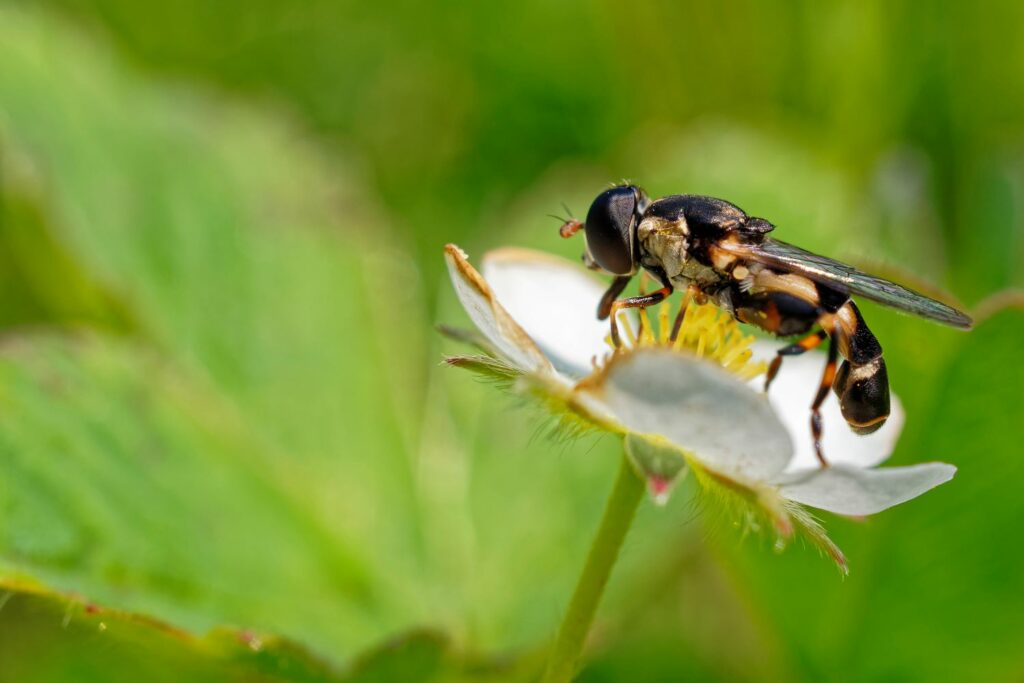Using volatiles helps attract and retain aphid-feeding hoverflies in soft fruit crops
13th December 2022
The findings of recent trials led by NIAB research assistant Adam Walker indicate commercial volatiles are effective at attracting and retaining aphid-feeding hoverflies in soft fruit crops and can be used to improve integrated pest management practices.

At the NIAB Soft Fruit Day technical webinar, entomologist and insect control expert Adam Walker presented the findings of two research projects aimed at improving early aphid control in soft fruit crops.
Setting the scene for his talk, Mr Walker explained that early season control of aphids in strawberry crops has been difficult in recent years, partly due to the withdrawal of effective actives. When applied, contact-acting biopesticides often don’t reach the aphids as they typically reside in the crown of the plant.
What’s more, aphids also overwinter in crops and can increase in numbers at relatively low temperatures. With the current lack of effective control methods, new strategies are needed to tackle this widespread issue in soft fruit crops, which forms the premise of Mr Walker’s research.
Trial one: testing the efficacy of commercial volatiles
The first trial was conducted over the span of two years and looked at whether it is possible to increase the early season control of aphids by releasing hoverflies and using volatiles to retain them. The project was supported by AHDB and several private companies.
Elaborating on the background of the trial, Mr Walker explained hoverflies are a predatory species with larvae that feed on aphids, therefore are ideal for use as part of an integrated pest management (IPM) programme in soft fruit.
However, hoverflies only migrate in these crops later in the growing season, which is why volatiles are needed to attract and retain them. These compounds have been formulated into dispensers and have proven to be effective at attracting hoverflies.
In the first year, Mr Walker and his team set up a field trial in spring 2021 on four soft fruit farms in Kent. Each farm received the following four treatments:
- Control
- Hoverfly release only
- Hoverfly + MagiPal volatile
- Hoverfly + modified volatile
Unfortunately, the results of the first year were inconclusive, possibly due to the low aphid establishment on plants which resulted in fewer hoverflies laying eggs, Mr Walker said. Hoverflies are most likely to lay eggs where aphids are plentiful in supply to increase the chances of their offspring’s survival, he explained.
Therefore, the key takeaway from the first year was that hoverflies are best released when aphid colonies are more established on plants to encourage egg laying.
The second year of the trial tested which volatile blends attract wild aphid-feeding hoverflies in soft fruit crops. To represent the spring and summer seasons, separate trials were set up in May and July 2022 in ten replicate polytunnels.
Each tunnel was then divided into five blocks, with a different treatment assigned to each block. One of the blocks represented the control, while the remaining four were supplied with different volatile blends.
The volatiles were placed in a white delta trap in the centre of each treatment plot underneath the tabletops so as not to interfere with spraying. After seven days, sticky inserts to the bottom of the traps so attracted hoverflies can be counted.
Mr Walker and his team found significantly more adult hoverflies in traps with volatiles than without, indicating that the compounds are indeed effective at attracting and retaining these beneficial insects. Moreover, six hoverfly species were identified from the traps, all of which are pollinators and produce aphid-feeding larvae.
In addition, no significant differences were found between the volatiles used, meaning they are similar in effectiveness and value to growers.
Trial two: hoverfly and volatile impact on a larger scale
The second trial conducted in 2022 compared crops with and without hoverfly and volatile treatment on a larger scale. Mr Walker and his colleagues set up the experiment on two farms in May, then carried out weekly assessments for a period of 12 weeks.
The trial layout consisted of a one-hectare treatment field, containing a hundred MagiPal dispensers at 10m intervals, where 1,000 hoverflies were released three times throughout the trial. Next to the treatment field, Mr Walker installed a section of buffer crops to prevent hoverflies from migrating onto the control field.
The results from the second farm revealed a significantly higher number of retained hoverflies and much lower aphid pressure in treated versus control crops.
However, when comparing the results to farm one, Mr Walker found much lower numbers of the released hoverfly species (Sphaerophoria rueppellii) and wild aphid-feeding hoverflies. The reason for this difference, he said, is likely the lower aphid pressure observed on farm one, which was less attractive to hoverflies.
In summary, Mr Walker deemed synthetic volatiles effective at attracting wild aphid-feeding hoverfly species, but remarked the crop survey technique used in the study may not be the best way to assess the number of adult hoverflies.
Moreover, the difference between farm one and two suggests hoverflies should be only released on farms once aphid numbers build up for best pest control results.
In his closing remarks, Mr Walker said more work needs to be done on the differences between commercially available hoverfly species and their interactions with aphids in soft fruit crops.
